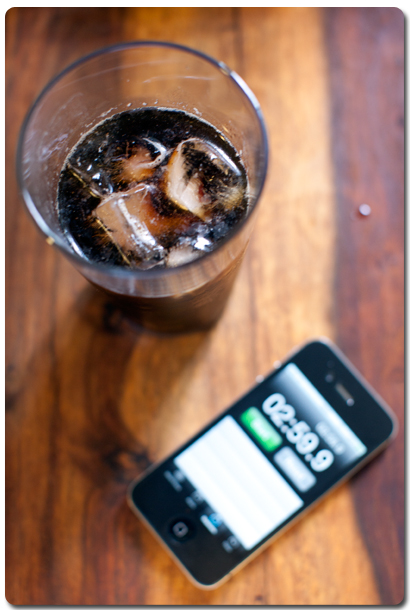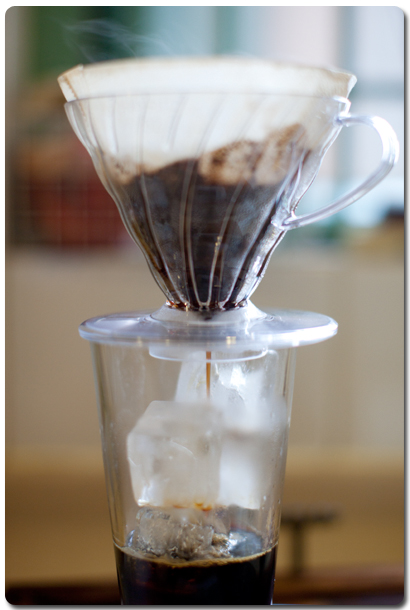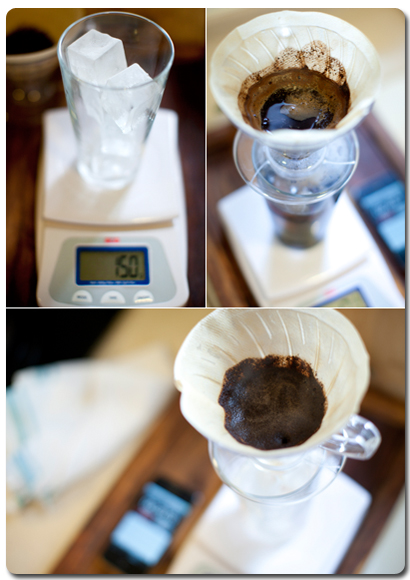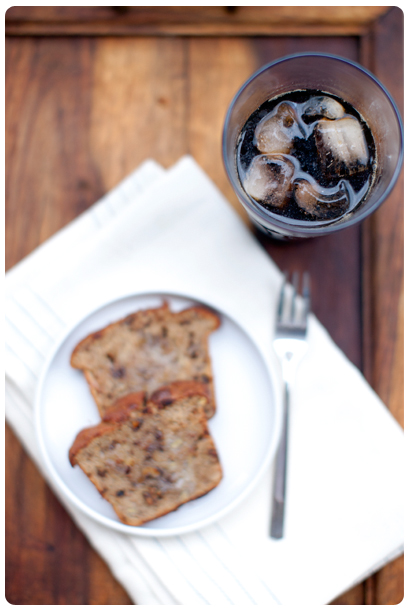Tuesday, September 11th, 2012...4:11 pm
Thinking Aloud: Iced Pour-Over

Summer in Hong Kong is coming to an end, but my love affair with iced coffee is an obsession that transcends all seasons and temperatures. Since writing that previous post on cold brew, I’ve finally admitted to being lactose-intolerant, given up milk (and sugar) in my coffee, received a Hario V60 set for my birthday last year (almost severed my right thumb when I didn’t realise that I had chipped the serving pot), and become a firm pour-over convert. (Wow – a lot can change in under three years!)
Because I have the tendency to procrastinate, I’ve run out of my cold brew stash far too many times over the course of these last two summers for my liking. As such, I’ve ended up looking into other methods of brewing iced coffee, particularly those that don’t involve quite as much forward planning. And, as eye-catching as a set up like the Hario Cold Water Dripper may be (Brandon, a contributor to the revamped and relaunched Chubby Hubby, wrote an excellent review of it here), our little HK apartment is already sorely lacking in countertop real estate, and – to be honest – I doubt I’d have the patience for it most days. My solution: iced pour-over.

There have been a number of articles written on how the Japanese method of brewing coffee directly onto ice results in the best of both worlds: the heat of the solvent (vs the cool or cold water used in the cold brew method) extracts all of the acids, oils and otherwise lost flavours that the coffee drinker does want, but having it brewed directly onto ice locks that flavour in (I’m not entirely clear on the chemistry behind this, but I suppose the concept is similar to flash-freezing meat or vegetables to retain freshness and nutritional content?) and cools it quickly, drop by drop, so you don’t end up with an entire glass of not-quite-cold and over-diluted coffee (which is what we often receive in cafes that just dump an already-diluted americano over ice), nor one that has sat around for too long whilst cooling and developed off flavours.
The method is pretty simple: you brew double strength coffee (i.e. using half the amount of water you’d normally use), and replace that portion of water with ice that is sitting in a glass directly under your filter. It sounds easy enough, but the first time I tried this, I ended up with coffee that tasted quite significantly weaker than the pour-over I was used to (with the same beans, and same bean to water ratio). I did a spot of googling, and it seems James Hoffman (who runs an incredibly informative coffee-related blog over at JimSeven) has written about why that might be the case in this post. His theory is that a higher percentage of the hot water gets absorbed by the ground coffee so you don’t actually get a 1:1 dilution factor with the ice. Although, not all of the ice melts when I make it, so I wonder how that – in turn – affects the dilution factor.

(For those of you with French presses and Melitta-style filters, you could also try out Hoffman’s French press/filter hybrid method for iced coffee. I’ve been wanting to give that a go, but glass coffee-making equipment doesn’t seem to last very long around me and I’m currently French press-less too.)
In any case, this is the method I’ve been using so far. I’ve stuck to my 16g water per gram of coffee ratio in my brew, but I’m pretty casual with the ice to water ratio. I tend to hover around 40:60 (ice to water), as I’ve found that a smaller percentage of ice means the ice starts to melt a little too fast, and the resulting brew isn’t as cold as I would like. I also use pretty large ice cubes (mine weigh in at around 25-35g per cube) so short of chipping away at my ice cubes it’d be hard to be any more precise than this. But the amounts I normally work with are around: 22g coffee, 150g ice, 202g hot water.
However, as much as I am currently enjoying my five-minute morning ritual of boil-measure-grind-rinse-weigh-pour, and the happiness of sitting in my balcony with a plate of homemade banana bread or hot toastie and my coffee, this is still very much a work in progress. And, I wouldn’t be at all surprised if I pop back in yet another (iced) coffee post in a summer or two. Who knows – I might even have gotten round to giving this pressurised cold brew a shot too. :D

Iced Pour-Over Coffee
I won’t bother writing out the full instructions, since if you own a drip filter, I’m sure you’re familiar with the mechanics of regular pour over already. If not, try taking a look at any of the articles I’ve linked at the end of the post for more in-depth write ups on both the regular and iced pour-over methods, many of those come with even more links for your coffee-reading spiral.
22g coffee
150g ice
202g hot water
Boil water, grind coffee, line cone with paper filter. Rinse filter.
Weigh out 150g of ice in a tall glass (I use the mixing glass side of a Boston shaker), and set the cone directly on top of the glass with ice. Transfer grounds into cone. Place the entire set up on a digital scale.
Tare scale. Pre-wet grounds with around 40g of water. Continue to add water until you reach 202g. The entire percolation process (excluding pre-infusion) should take around 3 minutes. Discard grounds, enjoy your delicious iced coffee.
Yield: Makes one large glass of iced coffee (or two tiny ones).
Related Reading/Links:
Coffee’s Slow Dance (pour-over, NYT)
Curious Cook | Iced Coffee and Tea: (Not) Taking the Heat (Harold McGee on iced coffee and tea, NYT)
Ristretto | On the Rocks (iced pour, T Magazine)
Ristretto | I Know What You Did Last Summer (cold brew vs iced pour, T Magazine)
My Current Iced Coffee Method (James Hoffman’s French press/filter hybrid method, JimSeven)
Pressurised Cold Brewing (pressurised cold brew, JimSeven)
Even More on Iced Coffee (iced pour, JimSeven)
Zen and the Art of Cold Brew Coffee (Hario Cold Water Dripper review, Chubby Hubby)

Comments are closed.